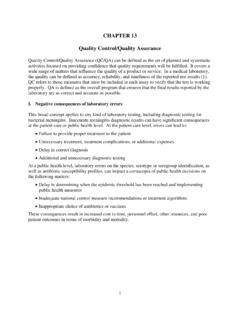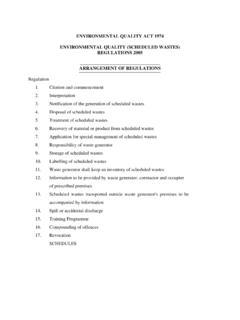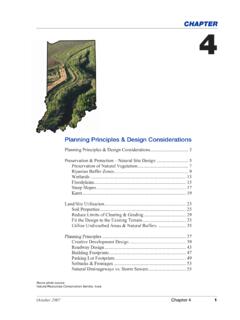Transcription of Terrorism and Security Issues Facing the Water ...
1 CRS Report for CongressPrepared for Members and Committees of Congress Terrorism and Security Issues Facing the Water Infrastructure Sector Claudia Copeland Specialist in Resources and Environmental Policy December 15, 2010 Congressional Research Service7-5700 RL32189 Terrorism and Security Issues Facing the Water Infrastructure Sector Congressional Research Service Summary Damage to or destruction of the nation s Water supply and Water quality infrastructure by terrorist attack or natural disaster could disrupt the delivery of vital human services in this country, threatening public health and the environment, or possibly causing loss of life. Interest in such problems has increased greatly since the September 11, 2001, terrorist attacks in the United States. Across the country, Water infrastructure systems extend over vast areas, and ownership and operation responsibility are both public and private, but are overwhelmingly non-federal. Since the attacks, federal dam operators and local Water and wastewater utilities have been under heightened Security conditions and are evaluating Security plans and measures.
2 There are no federal standards or agreed-upon industry practices within the Water infrastructure sector to govern readiness, response to Security incidents, and recovery. Efforts to develop protocols and tools are ongoing since the 9/11 terrorist attacks. This report presents an overview of this large and diverse sector, describes Security -related actions by the government and private sector since 9/11, and discusses additional policy Issues and responses, including congressional interest. Policymakers have been considering a number of initiatives, including enhanced physical Security , better communication and coordination, and research. A key issue is how additional protections and resources directed at public and private sector priorities will be funded. In response, Congress has provided $923 million in appropriations for Security at Water infrastructure facilities (to assess and protect federal facilities and support Security assessment and risk reduction activities by non-federal facilities) and passed a bill requiring drinking Water utilities to conduct Security vulnerability assessments ( 107-188).
3 When Congress created the Department of Homeland Security (DHS) in 2002 ( 107-297), it gave DHS responsibilities to coordinate information to secure the nation s critical infrastructure, including the Water sector. Under Homeland Security Presidential Directive-7, the Environmental Protection Agency (EPA) is the lead federal agency for protecting drinking Water and wastewater utility systems. Recent congressional interest has focused on two legislative Issues : (1) Security of wastewater utilities, and (2) whether to include Water utilities in chemical plant Security regulations implemented by DHS. In the 109th Congress, a Senate committee approved legislation to encourage wastewater treatment works to conduct vulnerability assessments and develop site Security plans. Similar legislation was introduced in the 111th Congress ( 2883). Congress also turned attention to legislation to extend DHS s Chemical Facilities Anti- Terrorism Standards and, as part of that debate, whether to preserve an existing exemption for Water utilities from chemical facility standards or to include them in the scope of DHS Security rules.
4 The House passed 2868 in November 2009, with a provision to require Water utilities to use safer chemicals and technology, but the Senate did not act on that bill or a companion Senate measure, S. 3598. Terrorism and Security Issues Facing the Water Infrastructure Sector Congressional Research Service Contents Introduction .. 1 Background .. 1 Responses to Security Concerns ..3 EPA .. 6 Reclamation and the 8 Department of Homeland Security .. 8 Coordination and Information Sharing .. 10 Policy Issues and Congressional 10 Congressional Activity .. 13 Appropriations .. 13 Legislative Issues .. 14 Water Utilities and Chemical Plant Security .. 16 Figures Figure 1. Water Infrastructure Security Appropriations .. 14 Contacts Author Contact Information ..18 Terrorism and Security Issues Facing the Water Infrastructure Sector Congressional Research Service 1 Introduction The September 11, 2001, attacks on the World Trade Center and the Pentagon have drawn attention to the Security of many institutions, facilities, and systems in the United States, including the nation s Water supply and Water quality infrastructure.
5 These systems have long been recognized as being potentially vulnerable to terrorist attacks of various types, including physical disruption, bioterrorism/chemical contamination, and cyber attack. Damage or destruction by terrorist attack could disrupt the delivery of vital human services in this country, threatening public health and the environment, or possibly causing loss of life. Further, since most Water infrastructure is government-owned, it may serve as a symbolic and political target for some. This report presents an overview of this large and diverse sector, describes Security -related actions by the government and private sector since 9/11, and discusses additional policy Issues and responses, including congressional interest. The potential for Terrorism is not new. In 1941, Federal Bureau of Investigation Director J. Edgar Hoover wrote, It has long been recognized that among public utilities, Water supply facilities offer a particularly vulnerable point of attack to the foreign agent, due to the strategic position they occupy in keeping the wheels of industry turning and in preserving the health and morale of the American populace.
6 1 Water infrastructure systems also are highly linked with other infrastructure systems, especially electric power and transportation, as well as the chemical industry which supplies treatment chemicals, making Security of all of them an issue of concern. These types of vulnerable interconnections were evident, for example, during the August 2003 electricity blackout in the Northeast United States: wastewater treatment plants in Cleveland, Detroit, New York, and other locations that lacked backup generation systems lost power and discharged millions of gallons of untreated sewage during the emergency, and power failures at drinking Water plants led to boil- Water advisories in many communities. Likewise, natural disasters such as the 2005 Gulf Coast hurricanes and 2007 Mississippi River floods caused extensive and costly damage to multiple infrastructure systems transportation, Water , electric power, and telecommunications. Background Broadly speaking, Water infrastructure systems include surface and ground Water sources of untreated Water for municipal, industrial, agricultural, and household needs; dams, reservoirs, aqueducts, and pipes that contain and transport raw Water ; treatment facilities that remove contaminants from raw Water ; finished Water reservoirs; systems that distribute Water to users; and wastewater collection and treatment facilities.
7 Across the country, these systems comprise approximately 77,000 dams and reservoirs; thousands of miles of pipes, aqueducts, Water distribution, and sewer lines; 168,000 public drinking Water facilities (many serving as few as 25 customers); and about 16,000 publicly owned wastewater treatment facilities. All of these systems and facilities must be operable 24 hours a day, seven days a week. Ownership and management are both public and private; the federal government has ownership responsibility for hundreds of dams and diversion structures, but the vast majority of the nation s Water infrastructure is either privately owned or owned by non-federal units of government. 1 Hoover, Water Supply Facilities and National Defense, Journal of the American Water Works Association, vol. 33, no. 11 (1941), 1861. Terrorism and Security Issues Facing the Water Infrastructure Sector Congressional Research Service 2 The federal government has built hundreds of Water projects, primarily dams and reservoirs for irrigation development and flood control, with municipal and industrial Water use as an incidental, self-financed, project purpose.
8 Many of these facilities are critically entwined with the nation s overall Water supply, transportation, and electricity infrastructure. The largest federal facilities were built and are managed by the Bureau of Reclamation (Reclamation) of the Department of the Interior and the Army Corps of Engineers (Corps) of the Department of Defense. Reclamation reservoirs, particularly those along the Colorado River, supply Water to millions of people in southern California, Arizona, and Nevada via Reclamation and non-Reclamation aqueducts. Reclamation s inventory of assets includes 471 dams and dikes that create 348 reservoirs with a total storage capacity of 245 million acre-feet of Water . Reclamation projects also supply Water to 9 million acres of farmland and other municipal and industrial Water users in the 17 western states. The Corps operates 276 navigation locks, 11,000 miles of commercial navigation channel, and approximately 1,200 projects of varying types, including 609 dams.
9 It supplies Water to thousands of cities, towns, and industries from the million acre-feet of Water stored in its 116 lakes and reservoirs throughout the country, including service to approximately 1 million residents of the District of Columbia and portions of northern Virginia. The largest Corps and Reclamation facilities also produce enormous amounts of power. For example, Hoover and Glen Canyon dams on the Colorado River represent 23% of the installed electrical capacity of the Bureau of Reclamation s 58 power plants in the West and 7% of the total installed capacity in the Western United States. Similarly, Corps facilities and Reclamation s Grand Coulee Dam on the Columbia River provide 43% of the total installed hydroelectric capacity in the West (25% nationwide). Still, despite its critical involvement in such projects, especially in the West, the federal government is responsible for only about 5% of the dams whose failure could result in loss of life or significant property damage.
10 The remaining dams belong to state or local governments, utilities, and corporate or private owners. A fairly small number of large drinking Water and wastewater utilities located primarily in urban areas (about 15% of the systems) provide Water services to more than 75% of the population. Arguably, these systems represent the greatest targets of opportunity for terrorist attacks, while the larger number of small systems that each serve fewer than 10,000 persons are less likely to be perceived as key targets by terrorists who might seek to disrupt Water infrastructure systems. However, the more numerous smaller systems also tend to be less protected and, thus, are potentially more vulnerable to attack, whether by vandals or terrorists. A successful attack on even a small system could cause widespread panic, economic impacts, and a loss of public confidence in Water supply systems. Attacks resulting in physical destruction to any of these systems could include disruption of operating or distribution system components, power or telecommunications systems, electronic control systems, and actual damage to reservoirs and pumping stations.












